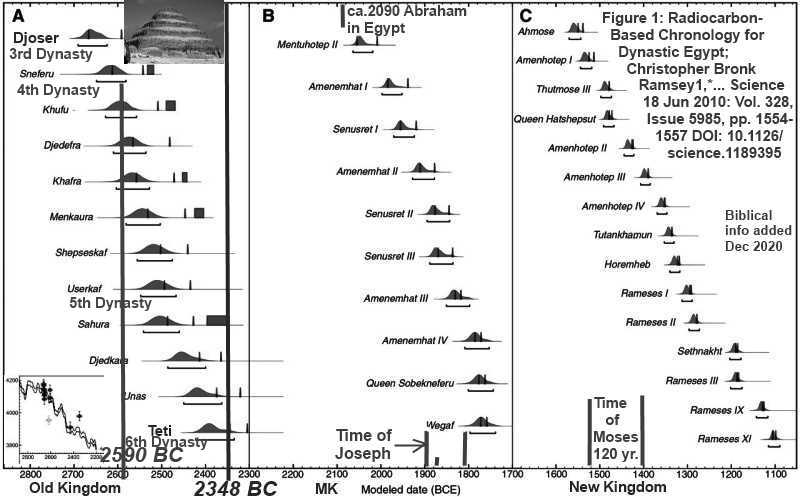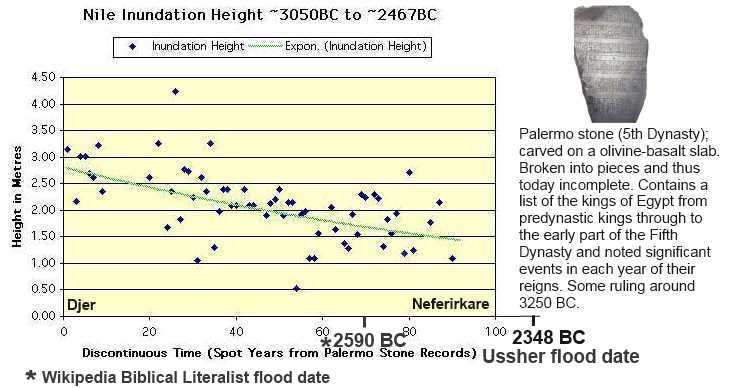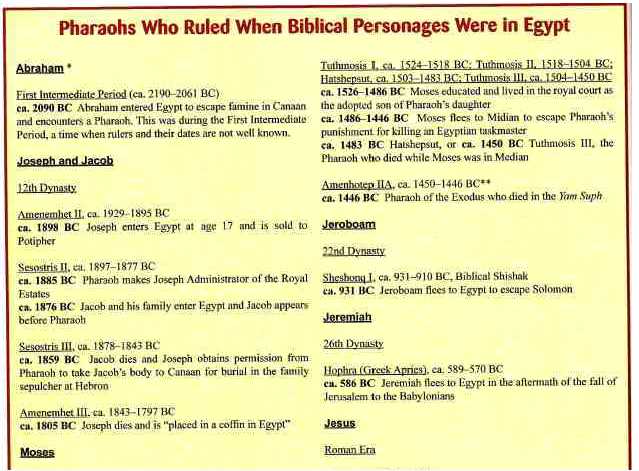In theory, history is arranged into 31 'Dynasties', each one being a collection of rulers from the same power base. This system was first employed by Manetho, High Priest and scribe at Heliopolis; who was ordered by Ptolemy II Philadelphus to write a history of the previous rulers. Manetho's list stretches from Menes (traditionally the first king of a unified Egypt) down to his own time. As well as the names of each king, he gives the length and some of the events of each reign. He was able to use the records held at the temple of Heliopolis, such as 'King Lists'. These original source documents have unfortunately, not survived, in many cases having been written on papyrus.
The Ancient Egyptians had no single, continuous era for counting years, such as our modern use of BC and AD. Instead, they dated documents and events by the year of the current pharaoh's reign. It is difficult to establish the exact order and length of each reign, as some kings ruled simultaneously in different parts of the country. There are ancient 'King-Lists', but these are not complete (sometimes for political or ideological reasons) and there are many gaps to fill.
Egyptian records of astronomical observations were sometimes dated by the king's regnal year. Using these rare occurrences we can attempt to calculate when this took place, giving a possible date BC in our own calendar. These are the cause of many arguments in egyptological circles however, so must be treated with the utmost caution.
While modern research has thrown up many inaccuracies (in particular the individual reign lengths) the order of the various rulers together with the breaks in Dynasty are still very largely as Manetho wrote it in the 4th Century BC. Egyptologists today divide Manetho's Dynastic system into historical eras; reflecting stages of political stability, divided by times of relative internal strife or transition called 'Intermediate Periods'.
|
Dynasty |
Approx. Dates |
Historical Period |
Capital |
| 5000-3150
BC |
PREDYNASTIC PERIOD |
||
| 5000-4000
BC |
Badarian |
||
| 4000-3500
BC |
Amratian (Naqada
I) |
||
| 3500-3150
BC |
Gerzean (Naqada II) | ||
|
0 |
3150-3050
BC |
ARCHAIC
PERIOD |
|
|
1 |
3050-2890
BC |
Memphis | |
| 2 |
2890-2686
BC |
||
| 3 |
2686-2613
BC |
THE OLD KINGDOM |
Memphis |
| 4 |
2613-2498
BC |
||
| 5 |
2498-2345
BC |
||
| 6 |
2345-2181
BC |
||
| 7
& 8 |
2181-2161
BC |
1ST
INTERMEDIATE PERIOD |
Memphis |
| 9
& 10 |
2160-2040
BC |
Herakleopolis | |
| 11 |
2134-1991
BC |
THE MIDDLE KINGDOM |
Thebes |
| 12 |
1991-1782
BC |
||
| 13
& 14 |
1782-1650
BC |
2ND
INTERMEDIATE PERIOD |
Delta |
| 15
& 16 |
1663-1555
BC |
Avaris | |
| 17 |
1663-1570
BC |
Thebes
| |
| 18 |
1570-1293
BC |
THE NEW KINGDOM |
Thebes |
| 19 |
1293-1185
BC |
||
| 20 |
1185-1070
BC |
||
| 21 |
1069-945
BC |
3RD
INTERMEDIATE PERIOD |
Tanis |
| 22 |
945-715
BC |
Bubastis | |
| 23 |
818-715
BC |
||
| 24 |
727-715
BC |
Sais | |
| 25 |
747-656
BC |
Kush | |
| 26 |
664-525
BC |
THE
LATE PERIOD |
Sais |
| 27 |
525-404
BC |
Persian
I | |
| 28 |
404-399
BC |
Sais | |
| 29 |
399-380
BC |
Mendes | |
| 30 |
380-343
BC |
||
| 31 |
343-332
BC |
Persian
II | |
| 332BC-323AD
|
GRAECO-ROMAN ERAS |
||
| 332-305
BC |
Macedonian
Empire |
||
| 305-30
BC |
Ptolemaic
Empire |
||
| 30 BC-323
AD |
Roman Empire
|
Also see Wikipedia-List of pharaohs
The above table starts at around 7000 B.P., however, very interestingly "11,600 years ago marked the beginning of the Rule of Mortal Humans on Earth according to Manetho (Egyptian historian ca. 343 BC)" prior to that was "Rule by Demigods and Spirits of the Dead (followers of Horus)". (from http://www.innerx.net/ personal/ tsmith/ iceciv.html) A very close correspondence to the indicated termination of the Younger Dryas (11,550 +-70 B.P. per the GRIP ice core data) and the time we would choose as the most likely time of the flood, and soon afterward the tribes would start multiplying and migrating from the "Ararat" area into lower lands of the most northern part of the fertile crescent where the archaeologists have uncovered the first evidences of large scale farming and community building, around 10,000 to 11,000 B.P..
You ask, why include a quote from an ancient Egyptian Historian who writes of "demigods and spirits of the dead".? "It is ironic that although great reliance is placed upon Manetho and his "Egyptian History", no full text of his work actually survives. Manetho's history is known to us because several writers whose works have survived quoted extensively from it. These writers included Josephus, writing in the late 1st century AD, Sextus Julius Africanus, writing around the year 220 AD, and Bishop Eusebius of Caesarea, writing in the early 4th century AD. Around five hundred years later, the works of Sextus Julius and Bishop Eusebius were used as a basis for a history of the world, written by George the Monk who was the secretary to the Byzantine Patriarch Tarasius (784-806 AD). All of these writers took only the extracts that they wanted from Manetho's work, so his account exists only in fragments within these later works." (from http://www.egyptologyonline.com/manetho.htm))
Much of the confusion has been cleared up by the results of a 2010 study.
BBC News: Radiocarbon dating verifies ancient Egypt's history By K. Moskvitch, BBC News, 17 June 2010
"Radiocarbon dating was used to show that the chronology of Egypt's Old, Middle and New Kingdoms is indeed accurate. The researchers dated seeds found in pharaohs' tombs, ...
They write in the journal Science that some of the samples are more than 4,500 years old."
"They dated 211 various plants, seeds and papyrus samples, obtained from museum collections."
"Thomas Higham, another member of the team who is also from the University of Oxford, explained that many items were found in ancient Egyptians' tombs and other archeological sites "where we could independently determine their historical age"." "We also used seeds from a room underneath the Saqqara step pyramid dated to a specific year of the reign of King Djoser," he said. (7 measurements with one spurious reading, obviously when dealing with such antiquities some out of place items may be mixed in with authentic items! )
The step pyramid of Djoser in Saqqara is believed to be the oldest stone pyramid in Egypt.
"The 6-tier, 4-sided structure is the earliest colossal stone building in Egypt. It was built in the 27th century BC during the Third Dynasty for the burial of Pharaoh Djoser. " (Wikipedia)
Dr Ramsey's team was able to determine the exact period when this king reigned Egypt - from about 2691 to roughly 2625 BC, said the scientist." (2667 BC accession per Shaw)
""For the first time, radiocarbon dating has become precise enough to constrain the history of ancient Egypt to very specific dates," said Dr Ramsey."(Note: 14C dating technology has been confirmed by studies in Israel at Biblical locations including the Siloam Tunnel @700 BC, Rehov@925 BC, and Shiloh@1050 BC.See Radiometric Dating)
"The modeling of the data provides a chronology that extends from ~2650 to ~1100 B.C.E. (Figs. 1 and 2 and Table 1). The benefits of using the reign order and length information together with the radiocarbon dates are greatest where density of dates is highest. In the NK (128 dates), the average calendrical precision is 24 years [95% highest posterior density (hpd) range] for accession dates (or 11 years for the 68% hpd range). In the MK, where dates are sparser and the uncertainty in the reign lengths is greater, the average calendrical precision is 53 years (95%); in the OK, where the number of dates is even lower, the precision is 76 years (95%) but is still markedly better than that possible with individual measurements."

The Step Pyramid of Egyptian Pharaoh Djoser was built before the Ussher* date of 2348 BC for the Noachian Flood !!
Even the youngest possible estimated accession date for Djoser at 2620 BC is still ~272 years before the Ussher date for the flood.
2348 BC as shown could be in the reign of Teti, the first Pharaoh of the Sixth Dynasty !!
Ancient lists of the early Pharaohs were found on: Den seal impressions (1st Dynasty) and the Palermo Stone.
Including Nile inundation heights starting during the reign of Pharaoh Zer (Djer) third ruler of the First Egyptian Dynasty. Using the ancient Egyptian royal cubit which was also used in the construction of the step pyramid of Djoser. (ref. The Oldest Records of the Nile Floods, by Barbara Bell, astronomer, Harvard College Observatory 1970 )

Obviously the annual depth of flooding of the Nile river was very important to the Egyptians.
The akhet, or Season of the Inundation, was one of the three seasons into which the Ancient Egyptians divided their year. It would be difficult to overstate the importance of the annual flood to Egyptian civilization. A moderate inundation was a vital part of the agricultural cycle; however, a lighter inundation than normal would cause famine, and too much flood water would be equally disastrous, washing away much of the infrastructure built on the flood plain. And as shown above this was also true before 2348 BC as well as after when they built elaborate structures called a Nilometer from which to make their observations. (see Nilometer-Wikipedia)
Before and after 2348 BC the Egyptian land and society existed with no major terrain changes, the Nile river was flowing and flooding before and after !! During this time period there is no evidence of a massive "global flood" !!
* Obviously many students have come up with many different dates for the Flood. Wikipedia-Biblical literalist chronology uses 2590 BC, 242 years earlier than that of Ussher. Still well within the range of 3050 BC to 2467 BC for the recorded Palermo Stone Nile inundation heights.

Appendix A

-.

